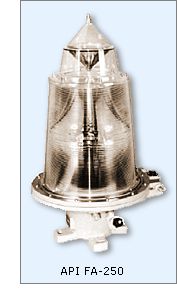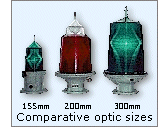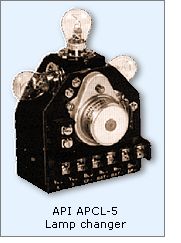 Automatic
Power Inc. manufactures all 250mm lanterns used in Great Lakes
lighthouses. The 250mm designation derives from the diameter of the lens
at the focal plane. Automatic
Power Inc. manufactures all 250mm lanterns used in Great Lakes
lighthouses. The 250mm designation derives from the diameter of the lens
at the focal plane.
 The
single-piece FA-250's acrylic Fresnel lens is available in clear, red,
green and yellow. It is a versatile unit that can be used as a 360°
omni-directional obstruction light, or can be adapted for multi-colored
flash applications through the addition of colored sectors. With a tight
o-ring seal around the base of the lens, dust and moisture are
completely excluded from the lamp mechanism. The
single-piece FA-250's acrylic Fresnel lens is available in clear, red,
green and yellow. It is a versatile unit that can be used as a 360°
omni-directional obstruction light, or can be adapted for multi-colored
flash applications through the addition of colored sectors. With a tight
o-ring seal around the base of the lens, dust and moisture are
completely excluded from the lamp mechanism.
The corrosion-proof anodized aluminum
base is sealed with two airtight O-rings. The lantern is hinged for easy
maintenance and adjustment access. Two ¾" NPT (National Pipe
Thread) fittings in the base provide electrical access and connection to
another lantern if required The lantern base is large enough to
accommodate a wide variety of flashers, lamp changers or controllers.
 In
order to reduce maintenance frequency, and to virtually eliminate the
chance of the light being extinguished when a bulb reaches the end of
its useful life, all of the 250mm lenses installed in Great Lakes
Lighthouses are outfitted with automatic lamp changers. While In the
early days, the term "lamp changer" befitted the purpose of
these mechanisms, in the modern digital age, lamp changers have evolved
to do a great deal more than simply rotating a new lamp into place when
the existing lamp no longer shows any resistance. In
order to reduce maintenance frequency, and to virtually eliminate the
chance of the light being extinguished when a bulb reaches the end of
its useful life, all of the 250mm lenses installed in Great Lakes
Lighthouses are outfitted with automatic lamp changers. While In the
early days, the term "lamp changer" befitted the purpose of
these mechanisms, in the modern digital age, lamp changers have evolved
to do a great deal more than simply rotating a new lamp into place when
the existing lamp no longer shows any resistance.
 API's
APCL-5 Flash changer features a number of capabilities. Available in for
use in either AC or DC voltage applications, with the DC version more
likely used in offshore applications in which power is supplied by a
photovoltaic array and batteries. It is a fully
integrated flasher and lamp changer unit providing for selection of a
combination of flash rhythms, voltage regulation points, and
communications addresses. It incorporates pulse-width modulated voltage
regulation, photocell control, solar charge regulation and a
surge-blocking diode. API's
APCL-5 Flash changer features a number of capabilities. Available in for
use in either AC or DC voltage applications, with the DC version more
likely used in offshore applications in which power is supplied by a
photovoltaic array and batteries. It is a fully
integrated flasher and lamp changer unit providing for selection of a
combination of flash rhythms, voltage regulation points, and
communications addresses. It incorporates pulse-width modulated voltage
regulation, photocell control, solar charge regulation and a
surge-blocking diode.
A standard serial communications
interface permits a wide range of remote monitoring and control
functions. The unit also provides a synchronization terminal, lamp-out
status or secondary optic control, electrical and optical monitoring of
each lamp, and built-in diagnostics via switch or radio activation.
When installed and adjusted properly,
the modern 250mm lens has a maximum visibility range of nine nautical
miles (approximately 10.4 statute miles.)
Reference
Sources

09/26/00, 10/14/00 & 10/15/00 emails from USCG
MK1 Sabo.
Product line catalog. Automatic Power Inc.
PowerPoint training presentation. 12 Volt DC Lantern repair.
USCG
|
 Automatic
Power Inc. manufactures all 250mm lanterns used in Great Lakes
lighthouses. The 250mm designation derives from the diameter of the lens
at the focal plane.
Automatic
Power Inc. manufactures all 250mm lanterns used in Great Lakes
lighthouses. The 250mm designation derives from the diameter of the lens
at the focal plane.
 The
single-piece FA-250's acrylic Fresnel lens is available in clear, red,
green and yellow. It is a versatile unit that can be used as a 360°
omni-directional obstruction light, or can be adapted for multi-colored
flash applications through the addition of colored sectors. With a tight
o-ring seal around the base of the lens, dust and moisture are
completely excluded from the lamp mechanism.
The
single-piece FA-250's acrylic Fresnel lens is available in clear, red,
green and yellow. It is a versatile unit that can be used as a 360°
omni-directional obstruction light, or can be adapted for multi-colored
flash applications through the addition of colored sectors. With a tight
o-ring seal around the base of the lens, dust and moisture are
completely excluded from the lamp mechanism. In
order to reduce maintenance frequency, and to virtually eliminate the
chance of the light being extinguished when a bulb reaches the end of
its useful life, all of the 250mm lenses installed in Great Lakes
Lighthouses are outfitted with automatic lamp changers. While In the
early days, the term "lamp changer" befitted the purpose of
these mechanisms, in the modern digital age, lamp changers have evolved
to do a great deal more than simply rotating a new lamp into place when
the existing lamp no longer shows any resistance.
In
order to reduce maintenance frequency, and to virtually eliminate the
chance of the light being extinguished when a bulb reaches the end of
its useful life, all of the 250mm lenses installed in Great Lakes
Lighthouses are outfitted with automatic lamp changers. While In the
early days, the term "lamp changer" befitted the purpose of
these mechanisms, in the modern digital age, lamp changers have evolved
to do a great deal more than simply rotating a new lamp into place when
the existing lamp no longer shows any resistance. API's
APCL-5 Flash changer features a number of capabilities. Available in for
use in either AC or DC voltage applications, with the DC version more
likely used in offshore applications in which power is supplied by a
photovoltaic array and batteries. It is a fully
integrated flasher and lamp changer unit providing for selection of a
combination of flash rhythms, voltage regulation points, and
communications addresses. It incorporates pulse-width modulated voltage
regulation, photocell control, solar charge regulation and a
surge-blocking diode.
API's
APCL-5 Flash changer features a number of capabilities. Available in for
use in either AC or DC voltage applications, with the DC version more
likely used in offshore applications in which power is supplied by a
photovoltaic array and batteries. It is a fully
integrated flasher and lamp changer unit providing for selection of a
combination of flash rhythms, voltage regulation points, and
communications addresses. It incorporates pulse-width modulated voltage
regulation, photocell control, solar charge regulation and a
surge-blocking diode.